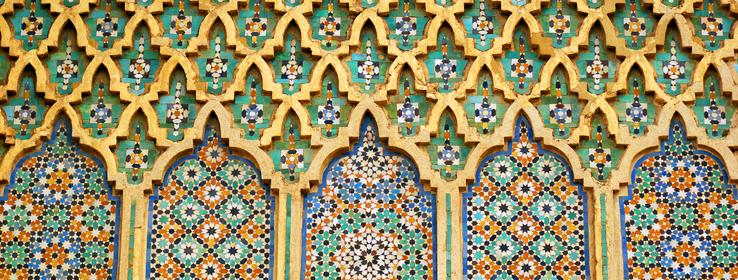BY KIM PALMER
A look at how color helps express the core beliefs of the world's major religions.
Buddhism: The rainbow of Nirvana
In late May, on the full moon of the lunar month, Buddhists observe Vesakha — the day marking the Buddha’s birth and enlightenment. Devout worshipers honor the occasion by donning plain white robes for prayer. But their minds and spirits will be a rainbow of color.
In Buddhism, color goes much deeper than surface decoration; it symbolizes state of mind. Buddhists believe that meditating on the individual colors and their essences is a way to achieve spiritual transformation.
Blue, for example, symbolizes coolness and infinity. Oxymoronically, the emotion associated with blue is anger, but meditating on the color is believed to transform anger into wisdom.
Red symbolizes blood, fire and the life force. It's associated with the notion of subjugation, but by meditating on the color, Buddhists believe the delusion of attachment can be transformed into the wisdom of discernment.
The highest state of all is to attain "rainbow body," when mere matter is transformed into pure light. Just as the visible light spectrum contains all color, the rainbow body signifies the awakening of the inner self to all possible earthly knowledge before stepping over the threshold to the state of Nirvana.
Hinduism: Vital red and sacred saffron
Designers and devout Hindus have something in common: They both know color plays an important role in creating an environment that enhances mood and well-being. In Hinduism, proper use of color is believed to keep people happy and cheerful. Hindu artists use color when representing the deities to symbolize their essential qualities.
Red, a sign of both sensuality and purity, is the hue used for important occasions, such as weddings, births and festivals. Brides wear red saris and put red powder on their hair parting, and at death, a woman's body is wrapped in red cloth for cremation. During prayer, red powder is tossed upon sacred statues, and deities who are brave are often shown wearing red.
Saffron, the burnt-orange hue of the precious spice, is also a sacred color in Hinduism. It represents fire and the burning away of impurities, and is the color worn by holy men.
Yellow is the color of knowledge and learning, happiness and peace. Lord Vishnu, Lord Krishna and Ganesha are traditionally shown wearing yellow, and single girls wear yellow to attract a mate and ward off evil spirits.
Blue is a brave and manly color, symbolizing determination and strong character. In Hindu religious art, Lords Rama and Krishna, who devoted themselves to protecting humanity and destroying evil, are often shown wearing blue and having blue faces.
Islam: A green tradition
When you visit mosques and other sacred Islamic places, chances are you'll see a lot of green. The hue has a special place in Islam, and is often used to represent Islam to other world religions.
Why is green so important? Some say green was Muhammad's favorite color and that he wore a green cloak and turban. Others believe the color symbolizes vegetation and life. In the Qur'an, it is written that the inhabitants of paradise will wear green garments of fine silk.
The color green is so strongly associated with Islam that it was absent in many medieval European coats of arms. During the Crusades, green was the color used by Islamic soldiers, so Christian soldiers generally avoided it.
Christianity: Colors in the sanctuary
While symbolic colors rarely appear in the Bible, color is widely used in Christianity, primarily in liturgical decorations, such as banners and vestments.
Black, which represents death, is the liturgical color for Good Friday. It can also represent sin, which results in death.
Blue, the color of the sky, is symbolic of heaven and of truth and is gaining favor as the color for Advent in order to differentiate it from Lent (see purple below).
Green is the color of plant life and spring and thus represents the triumph of life over death. It's the liturgical color for the Trinity season in some denominations and is also used during Epiphany.
Purple, the color for penitence and mourning, is the traditional color for the seasons of Advent and Lent. Purple is also the color of royalty, demonstrating the anticipation and reception of the coming “king” (Jesus Christ) celebrated during Advent.
Red, the color of blood and fire, is the liturgical color for Pentecost and to commemorate martyred saints.
White, a symbol of purity, innocence and holiness, is used during Christmas and Easter, and is sometimes represented by silver.
Judaism: True blue
Blue is often associated with the Jewish faith because it's the color used for Hanukkah decorations. But the hue has a much deeper symbolic significance. Blue represents the sky and spirituality. The Israelites used an indigo-colored dye called tekhelet for coloring clothing, sheets and curtains. In the Torah, the Israelites are commanded to dye one of the threads of their prayer shawl with tekhelet so that when they see it, they will think of the blue sky and God above them in Heaven.
Blue is also associated with the 10 Commandments. When Moses and the elders went up to Mount Sinai, they saw God standing on a sapphire pavement, and the tables of the law were made of sapphire stone.
Red and white also have significance in Judaism. Red symbolizes blood and sin, while white represents purity from sin. Red, white and blue represent fire, water and air, and also stand for judgment, kindness and mercy.
View Sherwin-Williams paint colors by family here.





